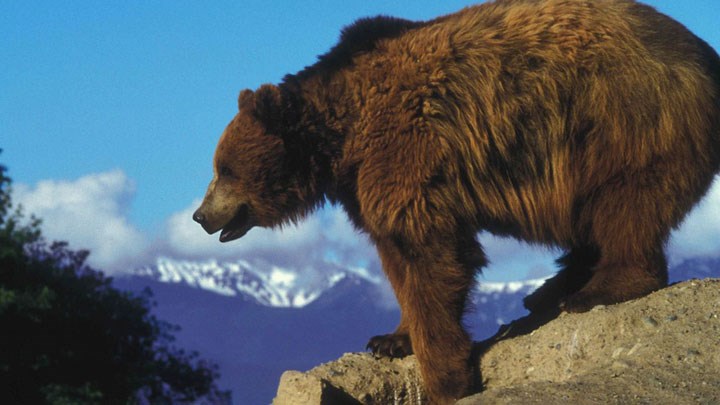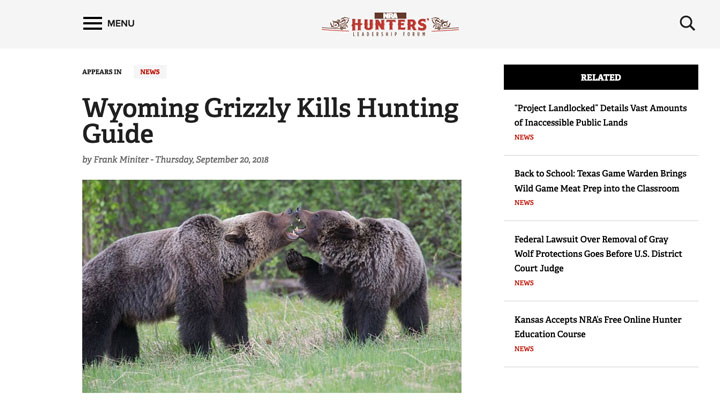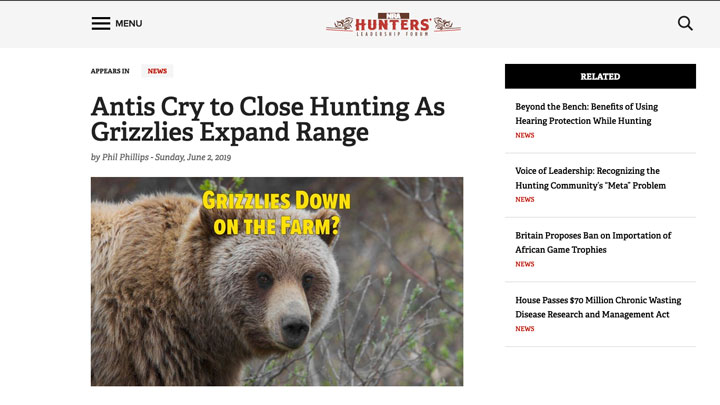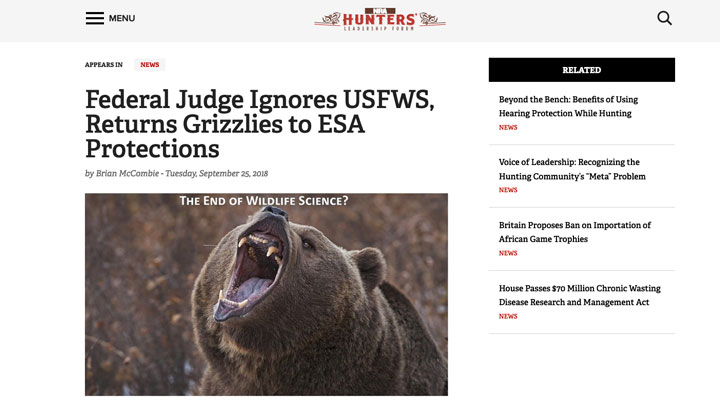
by Jim Zumbo - Monday, January 17, 2022

Picture yourself high on a Wyoming ridge. You and your buddies have just ridden your horses a half dozen miles from the trailhead. It’s a beautiful morning with blue skies, a light mountain breeze, and groves of beautiful yellow aspens scattered about in the dark Douglas fir forest. You dismount and spot some elk. Yesterday one of your buddies shot an elk in the area and now you’re fully aware that a grizzly may be in the area. As you glass the elk with your binocs, you suddenly hear a noise in the nearby timber. A grizzly bear appears 20 yards away and charges straight toward you. There is no time to react. In an instant the bear is on you and the furious grizzly knocks you to the ground.
That’s how Jeremy Dickson’s ordeal began this past October in northwest Wyoming 25 miles west of Cody. “When the grizzly charged it made sort of a squealing sound, kind of like a pig,” Dickson said. “It happened so fast I never got turned around to face it. I had a 10mm handgun in my chest holster but there was no time to use it. When I went down, the grizzly bit into my hand. My buddy, who was 20 yards behind me, shot the bear just behind the shoulder with his Remington .300 Win Mag. The wounded bear turned on my buddy, giving me a chance to shoot it several times with my 10mm. The grizzly dropped and my friend finished it with a couple more shots.”
All this happened in seconds. Dickson realized his thumb had been almost completely severed, hanging on by a shred of skin. Because adrenaline kicked in during the attack, he felt no pain until afterward. He and his partner were able to stop the bleeding from his hand and pulled a wool sock over it to keep it clean. They were able to get a cell signal and called for help. When he learned a life flight helicopter was three hours away, he and his pals rode their horses to the trailhead. He was flown to a hospital in Billings, Mont., where surgeons were able to reattach his thumb. It wasn’t until the helicopter approached the hospital that he felt his hand hurt. He spent several days in the hospital because doctors feared infection, which they always do after a grizzly mauling. The bear was a sow with two cubs, which explains the reason for the attack.
About a week later, 80 miles west of the Dickson attack, another grizzly was involved in an incident with hunters. Tyler Barnard was guiding two hunters near Jackson Hole, Wyo., where they were searching for a wounded bull elk. Suddenly the men smelled the carcass and were instantly attacked by a grizzly.
“The bear didn’t see me,” Barnard said. “It charged one of the hunters, who shot it between the eyes with a .45 handgun.” The bear never faltered, and in the melee that ensued, Barnard and the other hunter shot it numerous times. “I grabbed my 10mm from my belt holster and shot every bullet into the bear,” Barnard continued. “The other hunter also emptied his gun in it. The warden who investigated later said the bear was hit so many times it was hard to count the bullet holes.”
According to Barnard, the .45 bullet that hit the bear between the eyes never penetrated but deflected off the skull. The grizzly was also hit with bear spray by one of the hunters, but the spray had no effect. An investigation showed the bear had a tattoo showing it had been previously captured, was 20 years old and weighed about 500 pounds.
One might criticize both parties of hunters for putting themselves in dangerous situations in prime grizzly country. Dickson knew an elk had been killed the day before where he was hunting. Perhaps the sow was trying to chase them away from the gut pile. Barnard knew that following a wounded elk might end up with a grizzly encounter. Given this information, should they have abandoned the idea of entering those areas? In my opinion, it’s good to acknowledge risk but not necessarily to abort your plans to hunt. Risk is always there. Being prepared is mandatory. In each case, the hunters were armed and obviously were able to overcome their anxiety and react quickly. There are exceptions, such as places where grizzlies have been involved in a mauling and are still on the loose. Avoiding those spots is a prudent decision.
People often ask why lethal means had to be used instead of bear spray. Jeremy Dickson said, “That bear charged so fast I hardly had time to understand what was going on. If I had bear spray, I don’t believe I would have had time to get the can out of the holster, fool with the trigger mechanism and spray the bear. The attack was over in seconds. In my opinion, my gun is my bear spray.” In the attack on Tyler Barnard’s hunting party, one of the hunters sprayed the grizzly but the spray had no effect.
As reported by this NRA Hunters’ Leadership Forum website in 2018, three years before these incidents, a grizzly encounter with hunters ended tragically. Mark Uptain, an experienced guide, was guiding an elk hunter in the same general area where Tyler Barnard and his party were attacked. Uptain’s hunter killed a bull elk, and the men quartered it and planned to return the next morning to pack out the meat. Upon approaching the elk the next day, they were charged by a female grizzly with her male cub. The bears came on so fast there were only seconds to react. Uptain’s Glock 20 handgun and a canister of bear spray were out of reach. The hunter was closest and grabbed Uptain’s gun but was unfamiliar with it. He was unable to fire it and tossed it to Uptain, who couldn’t catch it. The enraged bear began to maul Uptain and the hunter, who was slightly injured but able to flee. Uptain was killed by the sow and possibly the cub as well. The next morning, several well-armed wardens and wildlife officials approached the area and were charged by the two bears. Both bruins were shot and killed.

In this instance the grizzly attack was obviously caused by the presence of the elk quarters. This scenario is a common cause of grizzly encounters during hunting season. Late afternoon is typically a prime time to hunt elk. Animals are in their beds during the day and begin moving out to meadows as the shadows grow long, where they’ll feed throughout the night. Savvy hunters often kill elk the last few minutes of shooting light. In remote mountain country, hunters typically leave the quarters overnight and return in the morning with pack animals. This is evidently what happened to Mark Uptain and his client. The bears found the meat during the night and laid claim to it.
To help prevent these encounters, the U.S. Forest Service requires hunters who kill elk on national forests to hang meat 10 feet from the ground and four feet from the trunk of a tree. While this sounds like a good law, it may be impossible to do so in some areas, such as brushy places where there are few trees or forests where trees grow so close together it’s not feasible to find a place with enough open space to hang meat. Elk quarters are heavy and may weigh as much as 80 to 90 pounds each. It may be a formidable task to hang the meat.
A good rule is to place the quarters in an open area away from the gut pile. As the meat is approached the next morning, it should be observed carefully from a distance to see if it’s been moved. If so, understand that there’s a high risk that a bear is close by, guarding the cache. There’s an old saying among Wyoming veteran elk hunters: “If a bear finds your elk quarters in the woods, it ain’t your meat anymore.” Wildlife officials strongly advise that if a grizzly has been feeding on the quarters or gut pile to leave the area immediately. After gorging themselves, bears will commonly bed very close to the meat to guard it, often where they can see it.
These recent aforementioned encounters with grizzly bears involve hunters in mountainous country, but many occur in campgrounds and some happen in urban or rural areas as well. I live in prime grizzly country between Cody, Wyo., and Yellowstone National Park’s (YNP) East gate. In fact, the Dickson incident happened a half dozen miles from my house. I’ve had grizzlies on my lawn, in my garden, on my decks and in my driveway. Once a bear got into my compost pile and wreaked havoc. Others enjoyed harvesting my veggies, especially carrots. An old mule deer doe that died a couple dozen yards from the house and was hidden by layers of snow was discovered by a grizzly and carried off and eaten. When I work in my woodpile, my .41 Ruger is always within an arm’s length from me. In the 35 years I’ve lived here, there have been no grizzly bear maulings in our valley, but in the nearby national forest, a grizzly was captured by the state wildlife agency and tattooed, tagged and turned loose. An elderly resident who lived in a forest cabin near the capture area decided to take a hike to that spot and was killed by the grizzly. In this case the bear possibly was reacting negatively by being handled by humans and the victim happened along at the wrong time.
I’ve lived here in grizzly bear territory for 35 years and personally have seen a huge increase in grizzly bear sightings in our neighborhood as well as in the nearby mountains. From a much larger perspective, grizzlies are far more numerous now in the Greater Yellowstone Ecosystem (GYE) then they were when they were listed as Endangered Species in 1975. According to the National Park Service, as this website reported, an estimated 136 bears Inhabited the GYE when they were listed. Now, about 728 live in the GYE. That’s a huge increase and doesn’t include grizzly bear populations in Montana and Idaho outside the GYE.

As grizzly bear populations continue to grow, so have interactions with humans, livestock and property. 2018 was especially rife with bear mortalities, with 68 bears being removed from the population. Locally, grizzlies were seen behind the Dairy Queen in Cody and in a cornfield near Lovell, more than 100 miles from YNP, which is the farthest bears have been seen from the park boundary. In 2021, 42 grizzlies had been removed from the population as of November.
Why are there so many more grizzly bear encounters and bear sightings in the recent past than years ago? The answer is simple and obvious: There are far more bears, and more people are moving into grizzly bear habitat.
It’s often asked why bears must be euthanized rather than put in zoos, wildlife centers or turned loose in remote areas where they’re apt to behave under wild conditions. Fact is, they’re indeed relocated to other areas if they meet necessary criteria. Bears that maul humans are usually euthanized instantly. Repeat offenders that simply can’t live without returning to their old habits are typically put down. Cattle killers are often relocated to areas where there is no livestock. Wildlife officials are frustrated because as the need to relocate more bears grows, there are fewer and fewer places to put them. Small cubs are usually euthanized along with the problem mother because their chances of survival alone are nonexistent in a land where boar grizzlies find cubs a tasty feast. Mountain lions, wolves and black bears also will prey on them. If they survive those apex predators, they’d be unable to dig a den themselves and would perish in the harsh Rocky Mountain winter.
Grizzlies evoke many polarized opinions, both from residents like me who live in prime bear country and from people who live in big cities around the country who have no firsthand knowledge of grizzly bear behavior. The subject of guns versus bear spray always comes up, not only after a mauling but during casual conversations. There are cases to be made on each side, but what it really comes down to is the circumstance of an attack. Gun proponents admit that user competency is of paramount importance. Arguments are made over the caliber, bullet, etc., but what it all comes down to is hitting the charging bear in a vital area, stopping it in its tracks.
Consider the scenario. You’re suddenly being charged by an enraged bear that is bounding over brush and logs and offering what might be the most challenging shot of your life—if you can get your gun out of its holster in time. Your brain will be of little use since you’re typically on the border of hysteria. If the bear initially appears far enough out, giving you enough time to draw your gun and settle into a solid stance, you’ll have a better chance of hitting it. But if you’re walking on a log or rocks or stumbling through a blowdown, you might have little or no opportunity to make an accurate shot. Bear spray offers the option of pressing the trigger and releasing a cloud of irritant that’s supposed to immediately attack the bear’s respiratory system. Tests have shown that spray may or may not be effective, depending on the bear’s adrenaline or other factors. Furthermore, the necessity of extracting the canister from the holster and preparing the firing mechanism may take more time than you have. And if the wind is in your face and the irritant blows back on you, the results could be catastrophic—and definitely not in your favor.
The subject of hunting grizzlies frequently comes up and is of huge interest nowadays from both the pro and con perspective. There is currently an effort to once again delist them, returning them to state jurisdiction rather than federal jurisdiction as is the case now. Over the years, litigation supported by anti-hunters has put bear hunting on hold. The biggest blockbuster case occurred a few years ago when Wyoming, Montana and Idaho cleared all the hurdles and were able to authorize a grizzly bear hunt, finally, after years of litigation. Wyoming had 22 hunters and Idaho had one hunter lined up to hunt the bears. At the last moment, literally, a liberal federal judge in Missoula, Mont., stopped the hunt.

In the meantime, grizzlies will continue to roam the mountains of the northern Rockies. Perhaps one day the stars will line up and a limited hunting season will be reality. One can only hope.
About the Author
Well-known in hunting circles, Jim Zumbo is an accomplished Western big-game hunter who also has hunted deer in all 50 states and pursues turkey, upland game and waterfowl. Backed by two degrees in forestry and wildlife, he has had more than 2,000 articles published in outdoor publications, written 23 hunting books and conducted numerous hunting seminars nationwide, including for NRA Hunter Services. In addition to serving as a full-time writer/editor for Outdoor Life magazine for 30 years, most of them as hunting editor, he was the host of “Jim Zumbo Outdoors” on the Outdoor Channel. A Benefactor Life member of the NRA, Zumbo has won numerous awards for his writing and remains active with conservation groups, including serving three terms on the Rocky Mountain Elk Foundation’s board of directors. His biography, “Zumbo: Based on the True Story of Jim Zumbo and His Blog Heard Around the World,” by K.J. Houtman was released in November 2016.
E-mail your comments/questions about this site to:
[email protected]
